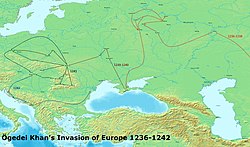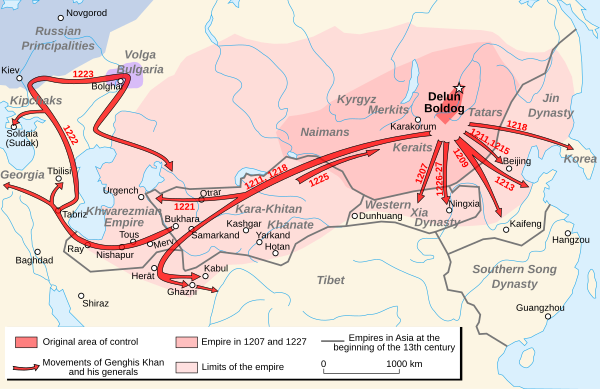Mongoļu iebrukums Eiropā
Izskats
| Mongoļu iebrukums Eiropā | |||||||||
|---|---|---|---|---|---|---|---|---|---|
 Mongoļu iebrukums Eiropā, 1236-1242 | |||||||||
| |||||||||
| Karotāji | |||||||||
|
(Mongoļu impērija) |
a) Kijivas Krievzeme valdības: Volgas Bulgāri Alani Kumani Adigi Ziemeļkaukāza cilvēki b) c) d) e) f) g) h) | ||||||||
| Komandieri un līderi | |||||||||
|
a) Batuhans Möngke Khan Subutajs Jebe Burundai Berke Orda Gujuks b) Baidar (iespējams †) Kadans Orda Khan c) Batuhans Subutajs Shiban Berke Burundai d) Batuhans Kadans |
a) Princis Mstislavs Mstislavičs Princis Yuri II of Vladimir † Princis Mstislavs III (kara gūsteknis) Princis Mstislavs II Khan Köten Princis Daniel of Galicia b) c) d) e) Karalis Bēla IV Ārpāds f) g) h) | ||||||||
| Spēks | |||||||||
|
a) Nezināms b) 10,000 kavalērija (viena Tumenu vienība)[1] d) 15,000–30,000 kavalērija (mūsdienu avoti)[2] citas aplēses: 70,000[3] 25,000[4][5] |
a) 25,000–50,000 iekļaujot garnizonus un ˞˞Kumānus [6] b) ~10,000 karavīri (2,000–8,000 Legņicā)[7] d) 10,000–15,000 karavīri (mūsdienu avoti)[8] citas aplēses: 80,000[9] 25,000[4][5] | ||||||||
| Zaudējumi | |||||||||
|
a) Minimāls b) Minimāls d) Daži simti karavīru nogalināti[10] f) 300–700 karavīri nogalināti |
a) 500,000 iedzīvotāji[11] tūkstošiem karavīru b) Smagi d) 10,000–20,000 karavīri nogalināti[5][12] 300,000–500,000 civilians[5] f) 100 karavīri nogalināti | ||||||||
Mongoļu iebrukums Eiropā notika 13. gadsimtā, kad Mongoļu impērija iebruka Eiropā, ceļā iznīcinot austrumslāvu valstis, kā Kijiva un Vladimira. Mongoļu iebrukumi sasniedza arī Centrāleiropu, kas noveda pie kariem, kuri izraisija sadrumstalotu Poliju, kā piemēram Legņicas kauja (1241. gada 9. aprīlī) un Mohi kauja (1241. gada 11. aprīlī) Ungārijas Karalistē.[13]
Uzbrukumus plānoja mongoļu karavadonis Subutajs (1175—1248) un komandēja Batuhans (ap 1207—1255) un Kadans (ap 1261), kas abi bija Čingishana mazdēli. Eiropas valdnieki sāka saprast, ka viņiem ir jāsadarbojās lai spētu pretoties mongoļu invāzijai.[14]
Kartes
[labot šo sadaļu | labot pirmkodu]| Šis ar vēsturi saistītais raksts ir nepilnīgs. Jūs varat dot savu ieguldījumu Vikipēdijā, papildinot to. |
| Šis ar militāro tematiku saistītais raksts ir nepilnīgs. Jūs varat dot savu ieguldījumu Vikipēdijā, papildinot to. |
Atsauces
[labot šo sadaļu | labot pirmkodu]- ↑ Sverdrup, p.114-115. Mongol sources state one tumen (standard tumens consisted of 10,000 men) was sent to Poland, while historians' estimates vary, with estimates of Mongol forces from 3,000 to 50,000.
- ↑ Sverdrup, pp. 114–115, citing Rashid al-Din's chronicles, 1:198, 2:152. Rashid Al-Din's figures give Batu and Subutai about 40,000 horsemen total when they invaded Central Europe in 1241 (including Turkic auxiliaries recruited since the conquest of Rus), divided into five columns (three in Hungary, one in Transylvania, and one in Poland).
- ↑ Carey states on p. 128 that Batu had 40,000 in the main body and ordered Subutai to take 30,000 troops in an encircling maneuver. Batu commanded the central prong of the Mongols' three-pronged assault on Europe. This number seems correct when compared with the numbers reported at the Battles of Leignitz to the north and Hermannstadt (Sibiu) to the south. All three victories occurred in the same week.
- ↑ 4,0 4,1 László Markó. Great Honours of the Hungarian State. Budapest : Magyar Könyvklub, 2000. ISBN 963-547-085-1Veidne:Inconsistent citations
- ↑ 5,0 5,1 5,2 5,3 Ervin Liptai. Military history of Hungary. Budapest : Zrínyi Katonai Kiadó, 1985. ISBN 963-326-337-9Veidne:Inconsistent citations
- ↑ Fennell, John. The Crisis of Medieval Russia: 1200–1304. London, 1983. Page 85. Excerpt: "If we assume that each of the larger cities could field, say, between 3,000 and 5,000 men, we can arrive at a total of about 60,000 fighting troops. If we add to this another 40,000 from smaller towns and from the various Turkic allies in the Principality of Kiev, then the total coincides with the 100,000 estimated by S.M. Solov'ev in his History o Russia. But then this is only a rough estimate of the potential number. We have no idea how many, towns and districts actually mustered troops- for instance, it seems highly unlikely that Novgorod sent any at all. Certainly none came to help their outpost at Torzhok. Perhaps then half or a quarter - or even a smaller fraction- of the total was the most the Russians could muster."
- ↑ Numbers disputed, vary from as low as 2,000 to above 10,000; see Battle of Legnica for further details.
- ↑ Sverdrup, pp. 114–115, pp. 109–110, contains lists of cited estimates provided by various sources and historians as well as the author's own estimates. The estimates for the Hungarian army at the time of the first Mongol invasion vary from not far above 10,000 (Grassman), to 25,000 (Jackson), to 50,000 (Kosztolnyik), to 65,000 (Sinor), to 80,000 (Todd). For his part, Sverdrup finds 10,000 to be the most likely estimate of those listed, based on other army sizes of the time and the fact that the 10,000 figure is attested to in two primary sources.
- ↑ Carey, Brian Todd, p. 124
- ↑ McLynn, p. 474
- ↑ «WAR STATS REDIRECT». users.erols.com. Arhivēts no oriģināla, laiks: 2004. gada 28. oktobris. Skatīts: 2018. gada 28. aprīlis.
- ↑ Sverdrup, p. 115. Citing: Gustav Strakoschd-Grassmann. Der Einfall Der Mongolen In Mitteleuropa In Den Jahren 1241 und 1242 (Innsbruck, 1893), p.183: 10,000 killed at Mohi.
- ↑ Thomas T. Allsen. Culture and Conquest in Mongol Eurasia. Cambridge UP.
- ↑ Francis Dvornik. The Slavs in European History and Civilization. Rutgers UP, 1962. 26. lpp.

